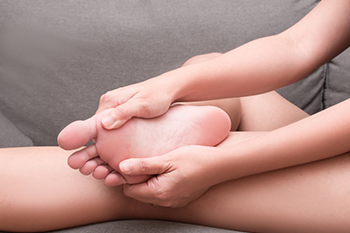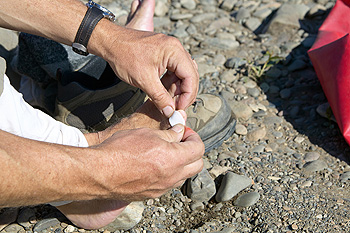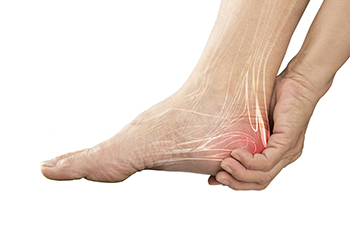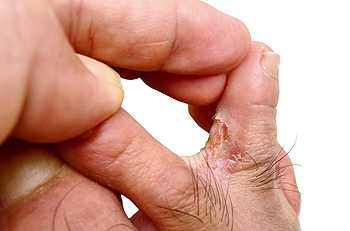Dallas (214) 340-8885
Athens (903) 677-9090
Gun Barrel City (903) 887-4341
Dallas (214) 340-8885
Athens (903) 677-9090
Gun Barrel City (903) 887-4341

Sesamoiditis is a potentially uncomfortable and painful condition that can threaten the health and vitality of your feet. The condition occurs when the two bones under the big toe joint, known as the sesamoid bones, become inflamed and irritated. This inflammation can occur in response to an injury or chronic causes. If you have sesamoiditis, you can experience a number of different symptoms. Most likely, you will experience pain when conducting weight-bearing activities or when applying pressure to the sesamoid bones. This condition can be painful and irritating, but there are several steps that you can take to mitigate its effects. Firstly, you can wear custom-made orthotics, or shoe inserts, that help you walk without putting pressure on the sesamoid bones. Altering your footwear may also help in reducing pain if you can find a pair of shoes that reduces the amount of pressure you exert on your big toe. In treating your sesamoiditis, you might also try to alter your daily routine to eliminate activities that put excess pressure on the feet and the sesamoid bones. If none of these or other treatments seem to reduce the pain felt from sesamoiditis, a surgical procedure may help provide the needed relief. If you believe that you might have sesamoiditis, it is always best to consult a podiatrist who will be able to properly diagnose your problem and propose a treatment plan.
Sesamoiditis is an unpleasant foot condition characterized by pain in the balls of the feet. If you think you’re struggling with sesamoiditis, contact Dr. Jonathan Kletz of Texas Foot Works. Our doctor will treat your condition thoroughly and effectively.
Sesamoiditis
Sesamoiditis is a condition of the foot that affects the ball of the foot. It is more common in younger people than it is in older people. It can also occur with people who have begun a new exercise program, since their bodies are adjusting to the new physical regimen. Pain may also be caused by the inflammation of tendons surrounding the bones. It is important to seek treatment in its early stages because if you ignore the pain, this condition can lead to more serious problems such as severe irritation and bone fractures.
Causes of Sesamoiditis
Treatment for sesamoiditis is non-invasive and simple. Doctors may recommend a strict rest period where the patient forgoes most physical activity. This will help give the patient time to heal their feet through limited activity. For serious cases, it is best to speak with your doctor to determine a treatment option that will help your specific needs.
If you have any questions please feel free to contact one of our our offices located in Dallas, Athens, and Gun Barrel City, TX . We offer the newest diagnostic and treatment technologies for all your foot and ankle needs.

A blister that forms on the skin of the feet is a common response to excess friction from shoes, or from an injury. It is defined as the body’s natural defense mechanism to protect damaged skin. A small area that is filled with liquid can form over the raw skin, and this protects the skin as new skin develops. It is important to cover the blister, and this can help to avoid premature popping. A loose elastic bandage generally works well, or some people use a padded bandage. When new skin has grown, the blister is no longer needed, and will gradually drain. Common reasons for patients to develop blisters can include wearing shoes that do not fit correctly, having an allergic reaction, or possibly from severe sunburn. Additionally, blisters may form from wearing damp socks, and it can help to wear socks that can absorb moisture. If a chemical spills on the feet, the result may be a blister forming. If you have blisters on your feet that are recurring, or if a blister has become infected, it is suggested that you consult with a podiatrist who can help you with treatment options.
Blisters may appear as a single bubble or in a cluster. They can cause a lot of pain and may be filled with pus, blood, or watery serum. If your feet are hurting, contact Dr. Jonathan Kletz of Texas Foot Works. Our doctor can provide the care you need to keep you pain-free and on your feet.
Foot Blisters
Foot blisters are often the result of friction. This happens due to the constant rubbing from shoes, which can lead to pain.
What Are Foot Blisters?
A foot blister is a small fluid-filled pocket that forms on the upper-most layer of the skin. Blisters are filled with clear fluid and can lead to blood drainage or pus if the area becomes infected.
Symptoms
(Blister symptoms may vary depending on what is causing them)
Prevention & Treatment
In order to prevent blisters, you should be sure to wear comfortable shoes with socks that cushion your feet and absorb sweat. Breaking a blister open may increase your chances of developing an infection. However, if your blister breaks, you should wash the area with soap and water immediately and then apply a bandage to the affected area. If your blisters cause severe pain it is important that you call your podiatrist right away.
If you have any questions, please feel free to contact one of our our offices located in Dallas, Athens, and Gun Barrel City, TX . We offer the newest diagnostic and treatment technologies for all your foot care needs.

One of the most common causes of heel pain is a condition known as plantar fasciitis. This involves inflammation of the band of tissue that runs from the heel to the base of the toes along the sole of the foot. Plantar fasciitis usually causes a stabbing pain in the foot, especially when first getting up in the morning. It is common to runners and people who are overweight. Some simple exercises and stretches can help to ease the pain of plantar fasciitis, and it is important to visit a podiatrist for an exam and diagnosis before embarking on any exercise regime. The standing calf stretch can help loosen the calf muscles that connect your leg to your heel. Stand facing a wall, touching it lightly with both hands. Place one foot straight back and bend the opposite knee while pressing into the wall. Change legs and repeat. A seated towel stretch can be felt in both the calf and the foot. Sit on a mat with both legs straight ahead. Wrap the towel along the ball of one foot and pull it toward you. Hold for 30 seconds and change feet. A podiatrist can recommend other exercises and therapies to ease the pain of plantar fasciitis.
Plantar fasciitis can be very painful and inconvenient. If you are experiencing heel pain or symptoms of plantar fasciitis, contact Dr. Jonathan Kletz from Texas Foot Works. Our doctor can provide the care you need to keep you pain-free and on your feet.
What Is Plantar Fasciitis?
Plantar fasciitis is the inflammation of the thick band of tissue that runs along the bottom of your foot, known as the plantar fascia, and causes mild to severe heel pain.
What Causes Plantar Fasciitis?
How Can It Be Treated?
While very treatable, plantar fasciitis is definitely not something that should be ignored. Especially in severe cases, speaking to your doctor right away is highly recommended to avoid complications and severe heel pain. Your podiatrist can work with you to provide the appropriate treatment options tailored to your condition.
If you have any questions please feel free to contact one of our our offices located in Dallas, Athens, and Gun Barrel City, TX . We offer the newest diagnostic and treatment technologies for all your foot and ankle needs.

Fungus causes athlete’s foot which is contagious and can be an uncomfortable and unsightly foot condition. Many people get athlete’s foot from warm and moist environments including public swimming pools, shower room floors, and locker rooms. The fungus can enter the feet through small cracks in the skin and can produce red and itchy areas on the feet. It may be more prevalent among people who sweat profusely or those who wear shoes and socks consistently causing the feet to lack air. A common location of athlete’s foot is between the toes and on the bottom of the feet. Additional symptoms include dry, scaly skin and blisters may develop in severe cases. The toenails are often affected causing toenail fungus. The chances of full recovery can improve when this foot condition is immediately treated. If you have symptoms of athlete’s foot, it is strongly suggested that you are under the care of a podiatrist who can effectively treat this condition.
Athlete’s Foot
Athlete’s foot is often an uncomfortable condition to experience. Thankfully, podiatrists specialize in treating athlete’s foot and offer the best treatment options. If you have any questions about athlete’s foot, consult with Dr. Jonathan Kletz from Texas Foot Works. Our doctor will assess your condition and provide you with quality treatment.
What Is Athlete’s Foot?
Tinea pedis, more commonly known as athlete’s foot, is a non-serious and common fungal infection of the foot. Athlete’s foot is contagious and can be contracted by touching someone who has it or infected surfaces. The most common places contaminated by it are public showers, locker rooms, and swimming pools. Once contracted, it grows on feet that are left inside moist, dark, and warm shoes and socks.
Prevention
The most effective ways to prevent athlete’s foot include:
Symptoms
Athlete’s foot initially occurs as a rash between the toes. However, if left undiagnosed, it can spread to the sides and bottom of the feet, toenails, and if touched by hand, the hands themselves. Symptoms include:
Diagnosis and Treatment
Diagnosis is quick and easy. Skin samples will be taken and either viewed under a microscope or sent to a lab for testing. Sometimes, a podiatrist can diagnose it based on simply looking at it. Once confirmed, treatment options include oral and topical antifungal medications.
If you have any questions, please feel free to contact one of our our offices located in Dallas, Athens, and Gun Barrel City, TX . We offer the newest diagnostic and treatment technologies for all your foot care needs.